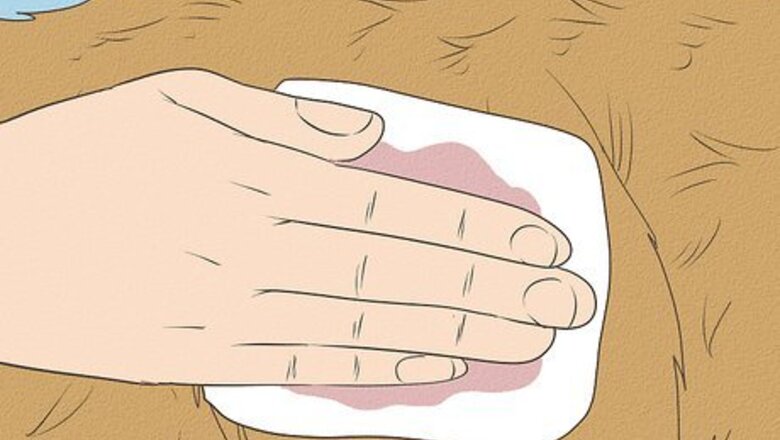
views
Stopping Life-Threatening Bleeding
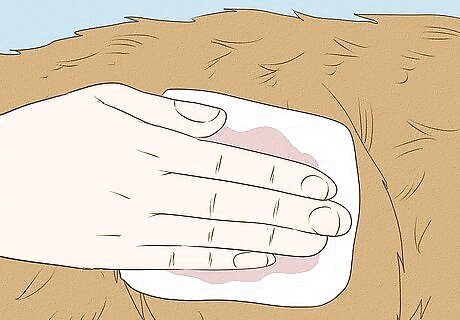
Put pressure on the wound if it is spurting blood. If your dog is bleeding intensely, put pressure on the artery or wound that's bleeding immediately. Use a clean cloth, towel, or other absorbent material like a diaper or menstrual pad. Spurting, fast-flowing blood is a sign of arterial damage that could lead to extreme blood loss or hemorrhaging. Be sure to keep constant pressure on the wound by pressing on it or wrapping a bandage around it. If blood begins to seep through the material you are holding over it, leave the first compress there and add another on top of it. Never remove a compress from a severe wound.
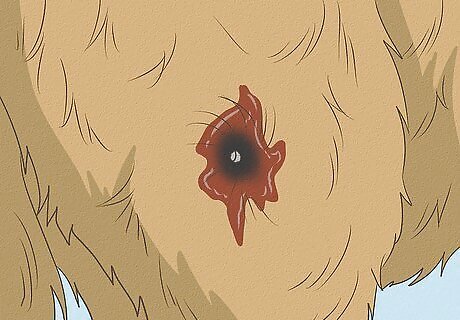
Do not remove any foreign objects from your dog's wound. If a foreign object has caused your dog's injury and is still lodged in the wound, leave it there. Removing it may cut an artery or cause further damage that will increase the bleeding and endanger your dog. Carefully put pressure on the wound around the object and wait for a veterinarian to remove the object safely.
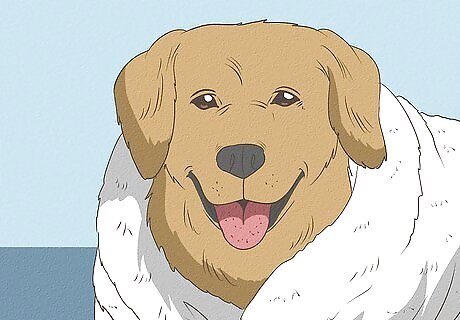
Wrap your dog in a towel or blanket to keep it calm and warm. Trauma can cause shock to your dog's nervous system. If possible, wrap your dog in a large blanket or towel before transporting it to the vet to help it relax and feel more secure. This will also immobilize your dog somewhat if it is struggling or acting aggressively. Symptoms of shock include shallow breathing, agitation, weakness, and rapid heartbeat. Do not assume that your dog is not in shock if you don't see signs right away. The early stages of shock can be hard to recognize.
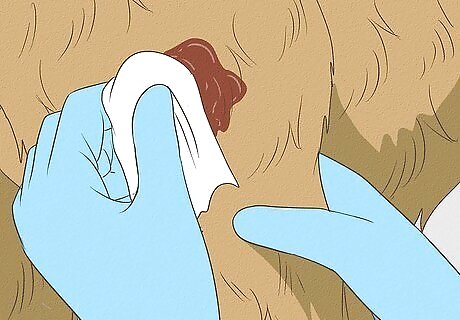
Keep pressure on the wound and get your dog to the vet quickly. Bring your dog to the nearest emergency clinic as soon as possible to be treated to minimize its blood loss. A vet should be able to stop the bleeding, remove any foreign objects, stitch up the wound, and check for internal bleeding. The vet may also be able to give your dog a blood transfusion or IV fluids if necessary. Keep the information for the nearest 24-hour veterinary clinic on your fridge or memo board to access easily in the event of an emergency.
Controlling Moderate Bleeding
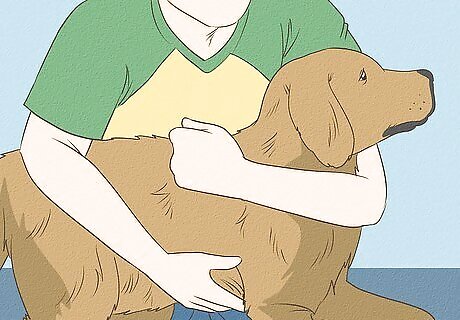
Restrain your dog if possible. If your dog is in pain it may struggle or bite while you try to treat its wound. If possible, have another family member or friend restrain your dog while you examine its injury. Be sure to handle your dog firmly but gently to avoid causing it extra pain. To restrain your dog, kneel down by your dog's side so you're facing its head. Then, take your arm that's furthest from your dog and hook it under your dog's chin. Take your other arm and wrap it around your dog's chest, behind its front legs. Finally, pull your dog close to your body and hold it there. Restraining your dog may help to calm it down if it feels panicked by its injury.

Muzzle your dog to avoid being bitten. Even the most docile dog may bite its owner after suffering a disorienting injury. Before treating your dog's wound, muzzle it gently to prevent biting. Be sure that the muzzle does not touch the wound. If your dog's wound is located too close to its mouth to muzzle it, proceed with caution. If you do not have a muzzle, you can wrap gauze around your dog's mouth temporarily to keep it from biting you.

Apply gauze to the bleeding area and put pressure on it for 20 minutes. If your dog has a small wound, cover it with a clean piece of medical gauze. Apply constant pressure to the wound for up to 20 minutes to slow or stop the bleeding. If your dog has a large laceration, place a clean towel over the wound. If the bleeding continues after 20 minutes, bring your dog to a vet right away.

Wrap a sports bandage around your dog to hold the bandage in place. Gently wrap a sports bandage or a long strand of soft material around your dog's head, limb, or torso to keep the gauze over the wound. Avoid wrapping it too tight, which may restrict your dog's breathing or circulation. Tie the bandage or material firmly with a knot. Avoid using tape to keep the bandage in place as it will adhere to your dog's fur and cause irritation and hair loss.
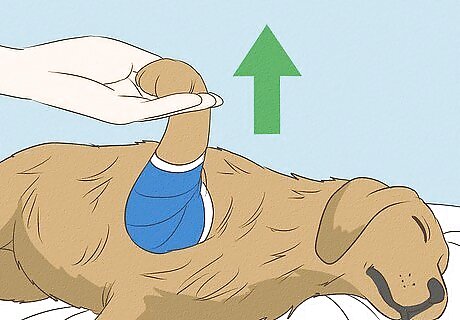
Raise your dog's limb above heart-level if it is bleeding. If one of your dog's front or back paws is injured, you can slow down the bleeding by raising it above heart level. This will be the easiest to do if your dog is lying on its side, with the injured limb facing upwards. Keep gentle pressure on the wound. Similarly, if your dog has an ear injury and long ears, gently pull the ear up above its head to help stop the bleeding.

Bring your dog to a vet as soon as possible after bandaging its wound. Your dog may get an infection if its wound is left untreated for more than a day or two. Bring your dog to a veterinarian as soon as you can to evaluate and treat the injury. Your vet can also provide advice for how to care for the wound while it heals. Your vet may also have to check for internal bleeding, depending on the injury your dog suffered.
Stopping Bleeding After Nail Trimming

Keep your dog still so that you can control the bleeding. If you accidentally cut one of your dog's nails too short while trimming it, make sure your pet doesn't run off and spread blood around your home. While the injury is not serious, it can bleed quite a bit. If possible, have a friend or family member hold your dog while you treat the nail. If you do not have another person to brace your dog, try to restrain it as gently as possibly using a leash if necessary.
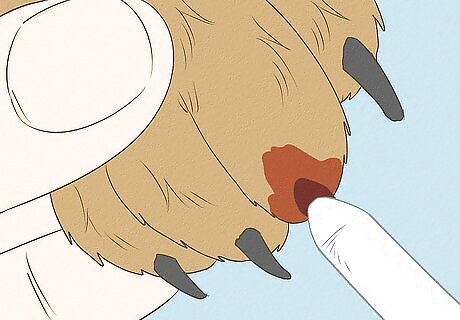
Use a styptic stick on the tip of the nail to stop the bleeding. Veterinarians use styptic sticks to stop bleeding nails quickly. If you have one on hand, gently press the tip to the injured nail for several minutes until the bleeding stops. Purchase styptics sticks at pets stores or online. Purchase styptic sticks to keep on hand in case of this kind of trimming accident. A styptic stick may cause temporary pain, but it will quickly stop the bleeding.
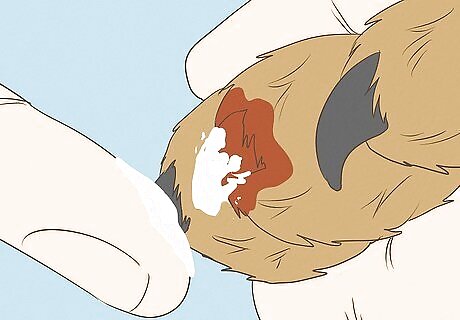
Use corn starch or flour if you don't have styptic sticks. In a pinch, place a small amount of corn starch or flour on your fingertip and press it into the tip of your pet's bleeding nail. The powder will help clot the blood after a moment or two. Keep light pressure on the nail until the bleeding appears to stop. Do not bandage your dog's paw, which might make walking difficult.












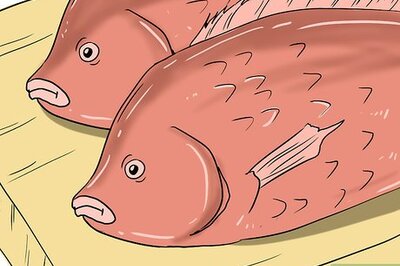
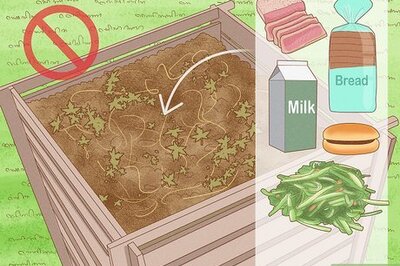





Comments
0 comment